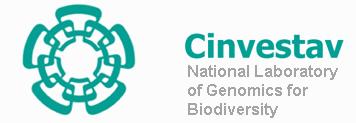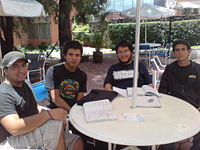Estudiantes de licenciatura crean Ciencia
medalla de oro en la categoría de Investigación Básica en Biología Sintética.- En la competencia International Genetically Engineered Machines (IGEM)
- Su investugación: Turing meets synthetic biology: self-emerging patterns in an activator-inhibitor network Turing meets synthetic biology:
self-emerging patterns in an activator-inhibitor network
LCG-UNAM-MEXICO & IPN-UNAM-MEXICO teams working together
When we heard that there was another iGEM team within our alma mater we started trying to contact them because we knew we could help each other to make better projects and produce better results.
This is how we found LCG-UNAM-Mexico iGEM team and since the early stages of our projects our team has been closely collaborating with them by exchanging ideas and discussing about experimental and theoretical issues we could have had in the future.
Before we started to implement our projects we had some meetings where we finally met them. In this meetings we exposed to each other the general ideas we had and the way we were planning to model and implement them. We recieved a valuable advice from them on our project, specially on the way we were planning to regulate our system using IPTG and aTc inversors and we mentioned them some theoretical issues they cuold have on the modelling of their system, and we offered to help them. We also kept an active online communication with them and we were always curious to know what the other team was working on.
When we were about to start implementing our system we had some bureaucratical issues on the customes with the current iGEM Kit Plate, and we needed some BioBricks of this Kit. Fortunately they already had it, so they kindly extracted, eluted, transformed, purified and sent them to us so we wouldn't lose more time. Certainly they saved us a lot of time, and we could started to work with a very little delay in comparison to the time we would have to wait for the arrival of the Kit. They also advised us in some technical details and tricks on the handling of the BioBricks, with good results in the wetlab.
When they were modelling they found some difficulties on describing the dynamics of the diffussion component of their system, so we assesed them on what finally would be their cellular automaton with discrete diffusion. Since they had some troubles with a continuous model we proposed them to use a discrete version of what they were trying to do: the discrete Laplace operator, or well a partial differential equations system. Finally they chose to use a discrete version of Flick's law to solve this problem, with good results on their drylab.
The collaboration between our team and LCG-UNAM was a very good idea, since it made things a lot easier for both teams and made possible to achieve better results. But definitely the best part of it was the creativity of our mutual contributions, since our teams together cover a very broad range of fields and we could complement each other very well. Two teams thinking together is better than one working alone.
Meeting Sep 19th 2009
Meeting CCG, UNAMValencia survey
Our team help Valencia team answering some questions about synthetic biology. It was a great experience and an excelent idea from the members of Valencia team to gather this kind of information. We want to congratulate them for this iniciative.
Tomado de El Universal
Luis, Ileana, Eniak, Jesús, Daniel, Gilberto, José, Alín, Román, Francisco y Cristian, que rondan los veintitantos, lograron derrotar a estudiantes de Harvard, Cambridge y otras en la competencia International Genetically Engineered Machines (IGEM).
Estudiantes de licenciatura de la Facultad de Ciencias de la Universidad Nacional Autónoma de México y del Instituto Politécnico Nacional obtuvieron una medalla de oro en la categoría de Investigación Básica en Biología Sintética.
Su proyecto fue reconocido por excelente trabajo en laboratorio, la calidad del modelo teórico y la vigencia y trascendencia del proyecto en biología y matemáticas, como aporte a la ciencia.
El trabajo interdisciplinar fue la clave para que el equipo de México inscrito desde 2006 obtuviera el reconocimiento en la afrenta científica.
Cruzando perspectivas
La biología sintética requiere del cruce de disciplinas para generar conocimiento y tecnología útil. La dinámica del equipo era expandir conocimientos básicos de matemáticas, computación, física, ingeniería genética y de la misma biología para después aplicarlo al proyecto inscrito.
"Unimos varios institutos, no sólo disciplinas; somos un grupo multidisciplinario y multicéntrico; la biología sintética propicia la integración de este tipo de vinculación", dijo Luis de Jesús Martínez Lomelí, de 21 años.
Tres sesiones de trabajo a la semana dieron frutos en los proyectos en el laboratorio durante las vacaciones de verano. Y cerca de 150 mil pesos, entre apoyos de instituciones y recoletas de amigos, para su propuesta, cifra inferior a los millones de dólares que lograron los otros competidores.
"Todos colaboraban, los matemáticos y físicos teorizan, los expertos en ciencias de la computación modelan y los biólogos y biomédicos experimentan", señaló Luis.
El equipo UNAM-IPN, fue fundado por el especialista del Instituto de Investigaciones en Matemáticas Aplicadas y en Sistemas (IIMAS) de la UNAM, Pablo Padilla Longoria; cuenta con el apoyo de investigadores del Centro de Ciencias Genómicas de Cuernavaca y del Laboratorio Nacional de Genómica para la Biodiversidad, del Centro de Investigación y de Estudios Avanzados del Instituto Politécnico Nacional de Irapuato, Guanajuato.
Las bacterias a tu servicio
Turing meets synthetic biology: self-emerging patterns in an activator-inhibitor network comprobó experimentalmente cómo la manipulación de genes a partir de modelos matemáticos y físicos podían ser visibles en un ser vivo.
El investigador Arturo Becerra explicó que la relevancia del proyecto es que logró resolver algunas preguntas de biología evolutiva a partir de la propuesta de Alan Turing sobre los patrones en un sistema genético que determinarán las formas, secuencia y color de las rayas de cebras o manchas de jaguares.
"Existen mecanismos que generen el desarrollo de las especies a través de patrones matemáticos, como las leyes de Turing que podría tener un papel en el desarrollo embrionario de los seres vivos".
El estudiante Jesús Pérez Juárez, de 27 años, explicó que la relevancia es que se logró diseñar el comportamiento de una bacteria al producir patrones de manchas en bacterias.
"Las aplicaciones es que se podrían crear organismos que puedan detectar contaminación y aislarla, así como generar fármacos de formas más baratas", indicó el estudiante de biología.
"Siendo estudiantes de licenciatura creamos ciencia y tecnología de punta", señaló Luis de Jesús Martínez.




No hay comentarios.:
Publicar un comentario